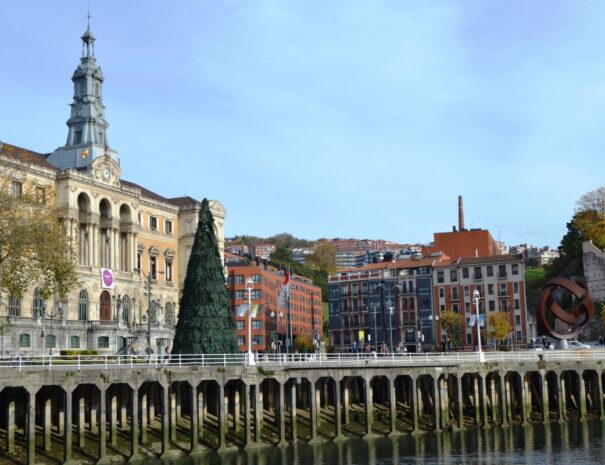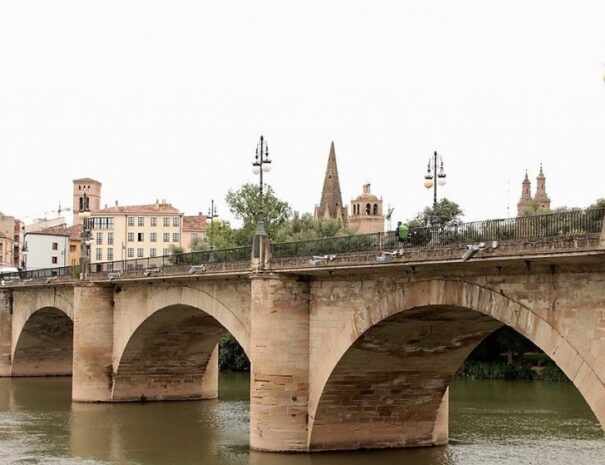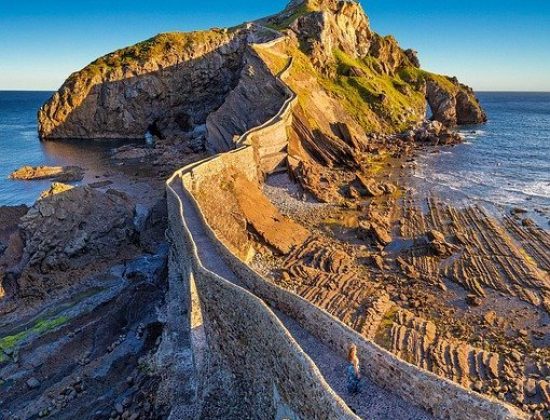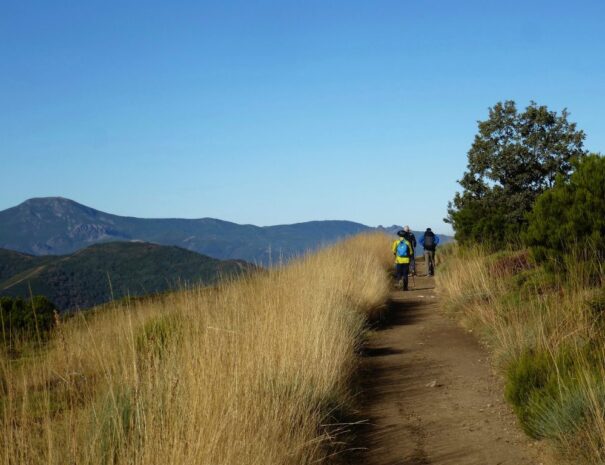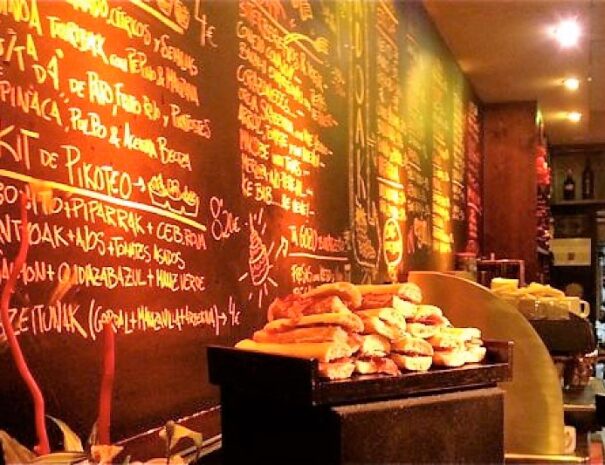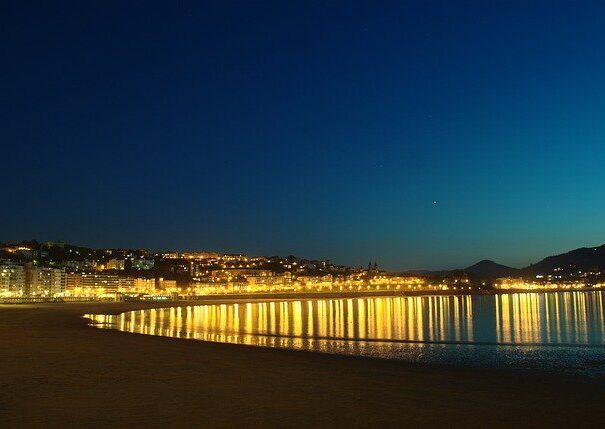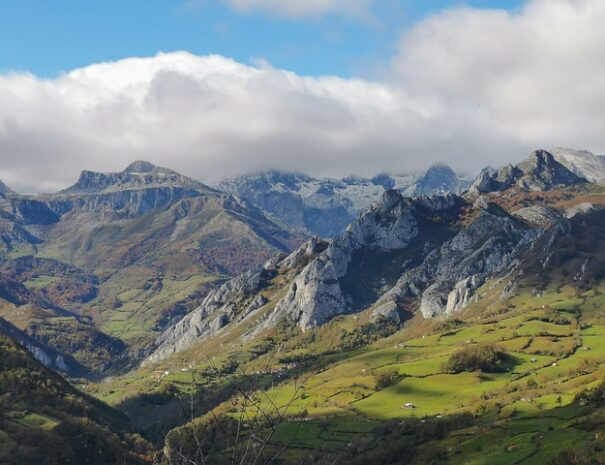
Northern Spain
The best travel guide to Northern Spain including top tours, hotels. gastronomy and routes
No one would say that Northern Spain is a “hidden gem” but it when most people think of Spain, what most people imagine is southern Spain: flamenco, bullfighting, beaches, paella, tapas, … So when people visit the northern part of the country they are usually blown away. The north of Spain is green and lush, brimming with history and culturally very different from the rest of the country (especially in the Basque Country). The food is different, the nightlife is different, … everything is just different. Different and amazing.
When we are talking about the north of Spain, we are talking about Galicia, Cantabria, Asturias, Navarra, Logroño, The Basque Country, and some northern areas parts of Castilla León and Aragón.
What follows is an introduction to this huge area in Spain. This post is useful as a first guide to draft your travel plan in northern Spain. You will find more detailed recommendations and information in each of our city or attraction guides. We hope you enjoy your travel planning!
Northern Spain travel guide - Contents
Our 3 top: hotels in Northern Spain
Hotel San Miguel – boutique hotel 5 minutes from the Cathedral of Santiago
Hotel de Londres - San Sebastian
Hotel Miró – 4 * - Amazing views
Northern Spain in a nutshell
Northern Spain has a very rich history and diverse local cultures. Galicia, for example, is located in the northwestern corner of the Iberian peninsula and is heavy influences by their neighbors to the south: Portugal. Galicians even have their own language that is a mixture of Castilian Spanish and Portuguese. It is a region with a strong maritime heritage and home to such amazing sites as the Cathedral of Santiago de Compostella, (where the famous Camino de Santiago concludes) and the mysterious Cies Islands.
The Basque country, on the other hand, is much more influenced by France. This influence is evident in Basque cuisine and food culture, which is considered to be world-class. The Basque people are very independent and proud and have conserved their ancestral culture for centuries. In fact, Basque or Euskera, the local language, shares no relationship with any other language on the planet. The main cities located in the Basque country are Bilbao, San Sebastian, and Vitoria, but there are tons of charming little villages, like Hondarribia for example, that is absolutely worth a visit.
Navarra, which was its own kingdom at one point is culturally similar to the Basque Country. Navarra’s main city and capital is Pamplona, where the famous running of the bulls takes palace but Pamplona and Navarra as a whole have a lot more to offer than just the San Fermines.
Cantabria and Asturias are the two regions of northern Spain that are more culturally Spanish, but there is also a heavy Celtic influence here that is unique to this region of the country. They are some of the most naturally beautiful areas of Spain. In this slice of Spain, the gigantic Picos de Europa mountain range bunches up just a few kilometers from the ocean, creating some of the most striking landscapes you will ever see. You have 2000 plus meters tall mountains just 5 km from the beach. The food in the area is also spectacular, hearty, and flavourful, perfect for seafaring folks like the Asturianos and Cantabros.
Top cities in Northern Spain
Bilbao is the largest city of the Basque country and the cultural and economical epicenter. Bilbao is a port city that is configured around the Nervión river that cuts through the city on its way to the Cantabrian sea. Bilbao is a beautiful and inviting city, home to the world-famous Guggenheim Museum. In the cities old quarter you will find all the pintxo bars and taverns the city is so well known for.
San Sebastian is also located in the Basque Country, just east of Bilbao, very close to the French border. San Sebastian is spectacularly beautiful, artsy, and deeply cultured. The city is built around a bay and features one of the most beautiful urban beaches in the world: la Playa de La Concha. San Sebastian is also one of the greatest food cities on the planet, having the largest concentration of Michelin Star restaurants of any city and the best pintxos in Spain. It also hosts the prestigious San Sebastian Film festival every year, a testament to the city’s relationship with the arts.
Logroño is the capital of La Rioja, an area of Spain mainly known thanks to the quality of its red wines! Logroño is the perfect city to stay while you enjoy wine tours in Rioja.
Pamplona is the capital of Navarra, which as we mentioned was once its own kingdom. Pamplona was basically a military fortress that grew and grew until it became a city. Pamplona was the main line of defense from invading forces from the north. It is of course also the site of the world-famous running of the bulls which, admittedly is something everyone should experience once in a lifetime, but Pamplona is a city filled with history and cool things to be discovered.
Santander is the capital of Asturias. Santander has historically been a very rich city as many residents took to the sea during the colonization of the Americas and made fortunes which they brought back to their hometown. But as beautiful as the city is, the natural beauty of the area is unbeatable. In Asturias, you will find some of the best beaches in the country and it is a prime destination for Suffers. Also, make sure you order a Cachopo if you visit, you can thank us later.
Santiago de Compostela is also a capital city, this time of the region of Galicia. Santiago is home to the Cathedral of Santigo de Compostela, perhaps the most spectacular such Cathedral in Europe, only rivaled by the Notre Dame in Paris. Santiago is also the finishing point of the famous Camino de Santiago. Santiago is immensely beautiful and a perfect example of Galician culture.
Top attractions in Northern Spain
Cathedral Santiago
A visit to the cathedral is a must for anyone in Santiago de Compostela. The Cathedral is in the top 3 centers for catholic pilgrims in the world. There has been a place of worship in the same place since the 9th century and ever since then the building has been renovated and added on to until we have the spectacular cathedral you see today. The cathedral is enormous and The interior in particular is a masterpiece of Romanesque architecture. Around the nave and aisles, there is a string of chapels, which are mostly Romanesque with exquisitely decorated altars, tombs, and statues.
The Guggenheim Museum of Bilbao
Designed by Frank Gehry is the city’s most emblematic monument. The museum sits on the bank of the Nervión river and is itself a piece of art. The museum is one of the most important examples of contemporary architecture, and has been hailed as a “signal moment in the architectural culture”. The museum finally opened its doors on 18 October 1997 and was inaugurated by the King, Juan Carlos I of Spain. The Guggenheim is home to over 250 works of art and features permanent and visiting exhibits of works by international and national artists.
La Concha beach in the heart of San Sebastian
It’s almost not fair to include it on this list, it is almost like saying that one of San Sebastian’s main attractions is the whole city of San Sebastian. La Concha is considered to be one of the most, if not the most spectacular and pristine urban beaches in the world. As an added bonus, many of the city’s other attractions are within walking distance from the beach or are literally beachfront properties.
Citadel of Pamplona
Pamplona was, for the longest time a military garrison, designed as a stopper for invading forces from the north. As time went on and more people attempted to invade the peninsula the fortress began expanding and the webbing of protective walls became more intricate and sophisticated. The end result was a European heritage site and one of the largest and most complex military constructions in all of Europe.
But there is so much more to enjoy in Northern Spain. You can find below some of the visitors´’ guides for some of the top attractions in the North of Spain.
Top Northern Spain Road Trip
This itinerary lets you enjoy Barcelona and all the Northern coast of Spain. We believe 11 days is the minimum time to enjoy this long itinerary in Northern Spain. You may decide to stay more time at different locations or enjoy smaller towns and villages in the area. This itinerary focuses on the main stops throughout the route and proposes ways to expand the itinerary in case you have more days available.
For each main stop, you will be able to access detailed city guides where you will find all you need to plan your stay at each of the cities on this northern Spain itinerary: recommended hotels, restaurants, monuments, tours, activities, and nearby trips.
- Barcelona (2 1/2 days): Barcelona, the first stop in this itinerary through northern Spain, is one of Spain´s most European cities. Modern, busy… but it offers so much more: Gaudi architecture, beaches, bars, and food markets, a fantastic Gothic district, and beautiful squares with a truly Mediterranean flair. Barcelona is also easy and very pleasant to walk. The city is very flat and boasts two super avenues that are amongst the must-do: Paseo de Gracia (a must to enjoy Gaudi and modernist architecture) and Las Ramblas, one of the most lively pedestrian streets in the world. You will need at least two days to enjoy Barcelona and your stay could easily be extended to visit Montserrat monastery and the nearby wine regions of Penedes or Priorat. Art lovers will find lots to do, families can enjoy theme parks at the top of a hill, and sports lovers can visit the Barcelona football stadium. Also, north of Barcelona, the coast of Girona offers both ideal beaches and small villages that contrast and fun and party resorts.
- Zaragoza (1/2 day): Zaragoza makes for the perfect stop on your way to the Northern coast of Spain from Barcelona. Zaragoza is the capital of Aragon and holds half of the region´s population. It is located next to the Ebro river (second largest in Spain) and has a long history that takes us back to Roman days. The top highlight in Zaragoza is El Pilar, a huge basilica that cannot be missed in the city center. Baroque style with splendid domes and the treasure of the Pilar statue, hidden in the Capilla Santa. Besides El Pilar you it makes all sense to pay a visit to La Aljafería, a Moorish palace that was restored and is home of the regional parliament (yet it can be visited). There are also four museums dedicated to the Roman history of Zaragoza.
- Pamplona (1/2 day): For most, Pamplona is the city where San Fermin takes place. Despite Pamplona cannot be understood without San Fermin and the running of the bulls, Pamplona offers more than this festival. We love the restaurants and bars in Pamplona, where you will find great value for money and gastronomy that is true to its region. Pamplona is an important stop in El Camino, and there are some beautiful squares and interesting monuments and museums to keep yourself busy. San Fermin is with no doubt the highlight for the city, and one of the top things to do in Spain in July. But accommodation prices rise considerably during San Fermin and the city is too busy for travelers that will prefer to discover Pamplona when it gets back to normal.
- Laguardia (1 day): Driving from Pamplona to Laguardia will take you a bit more than one hour. Laguardia is part of the Basque Country and inside the Rioja wine region. Rioja is a beautiful region well-known thanks to its wine. For many people, this is an amazing region, perfect to walk along small roads, visiting quaint villages, and indulging yourself with wine and local gastronomy. Laguardia is a perfect place to enjoy Rioja, though some may prefer Logroño, larger and with one of Spain´s top districts for tapas: Calle Laurel. Laguardia is medieval, small, and beautiful. Logroño is a city, an important stop in El Camino de Santiago, and a paradise for tapas. The decision on where to stop is yours.
- San Sebastian (2 days): For many of Spain´s smartest city, San Sebastian offers one of the world´s best city beaches, La Concha, and a paradise for foodies. Once the summer destination for the royal family, San Sebastian has known how to retain the glamour of its many famous visitors, including the mysterious Matahari. We are sure you will fall in love with San Sebastian, which also offers the possibility to enjoy nearby beautiful towns like the fishing port of Getaria (famous besides the port for its txakoli wineries and also for its restaurants that specialize in grilled fish and meat) or Hondarribia, from which walls you will be able to enjoy views of neighboring France. If you have enough time it would be a good idea to stay a bit longer in San Sebastian and discover the French Basque country (Saint Jean de Luz or Biarritz).
- Bilbao (1,5 days): Your next stop in this itinerary through Northern Spain is a city that has transformed itself. Bilbao is today one of Europe´s top art cities. Its top icon, the Guggenheim is an immense titanium fish that holds an important modern art museum, though for most visitors the building is the major piece of art. Despite the city has evolved and modernity is felt in obvious ways, Bilbao remains true to its origins and we are sure you feel its pride and character in many small details. Bilbao holds a past connected to iron and shipbuilding. In Bilbao, you will find not just art, but also pintxos and wine bars, interesting food markets, and a very interesting day trip to discover top attractions like the Unesco-listed Puente Colgante or the now-famous Hermite of San Juan de Gaztelugatxe.
- Santander (1 day): Santander and surrounding towns are popular summer destinations for Spanish citizens. The city is located at a privileged location by the seaside, next to the Bay that holds its name. Santander is a perfect place from where you can explore Cantabria. Nearby Santillana del Mar, a beautiful mid-sized tow, boasts one of the best prehistoric art caves in the world. Comillas, home of one of Spain´st top Universities, offers an interesting stop west of Santillana and Santander, with a beautiful beach and a pleasant old quarter. If you travel with children make sure you pay a visit to Cabarceno, an open-air zoo that you visit with your car (it holds 20 kilometers of roads) and where all sorts of animals live in large areas that used to be open-cut mines.
- Gijon (1/2 day): Gijón rivals with Oviedo as the top city in Asturias. Gijón is still today an important industrial centre, but as in the case of Bilbao, it has evolved and transformed into a very pleasant city to live and visit. It boasts a fantastic beach that offers a great seafront walk and its old district is full of bars and taverns where you can taste the delicious (and cheap) Asturian specialties like fabada. Gijon is a perfect place from where to enjoy Picos de Europa national park, many small villages like Tazones or Cudillero or the famous cider from Villaviciosa.
- Lugo (1/2 day): Lugo is the next stop in this itinerary in Northern Spain. A city not so well-known if compared to some of the other recommended stops in the itinerary, Lugo will for sure surprise you with its beautiful Roman walls and the labyrinth of small pedestrian streets and squares located withing the old fortress. Known as Lucus Augusti, Lugo was the most important town in Galicia during Roman times. The city hold the reputation of serving the best octopus in Spain: pulpo a feira is a local dish you should give a try.
- Santiago de Compostela (1 day): It is not unintentional that we have leaved Santiago de Compostela as the last stop in this itinerary through North of Spain. Santiago is the capital of Galicia, and the end of the Camino de Santiago. Hundreds of thousands of pilgrims come from all over the world every year to enjoy El Camino, or at least part of it. Arriving to Santiago is a great feeling for all those who have walked for weeks. And we are sure it will also be a very rewarding experience for you despite you may have traveled comfortably in your car. Santiago de Compostela is a very special place, where lots of emotions get together, where great food and wine is served, and where locals, university students, pilgrims, and tourists in general find what they are after.
3 great tours in Northern Spain
Guggenheim private tour
Top Seller small grouop evening Pintxo tour
Best way to visit Northern Spain
If you arent up to attempting the “French way” portion of Camino de Santiago on foot, perhaps your best option would be to rent a car to get from one place to the next. Everything is relatively close. If you were to drive from San Sebastian to La Coruña, which would take you from one end to the other, it would take you about 6 hours. So, a great option is to choose a hub city and plan day trips from there.
Santander is the most central large city in the region, so logistically this is a great option. Another great option, especially if you are flying into Spain is to travel to Bilbao and plan your trips from there. San Sebastian and a great number of other attractions are within driving distance from Bilbao, but you probably won’t make your way all the way to Galicia unless you’re up for a good old road trip.
Weather In Northern Spain
Although the winters can get colder and wetter than in the rest of Spain, that does not mean that it is dreary all the time. There are two distinct climates in the north of Spain:
The oceanic climate is typical of the extreme north, an area that is also known as “Green Spain”. This climate extends from along the coast of Galicia all the way to the Pyrenees, affecting the north of Galicia, Asturias, Cantabria, and the Basque Country. The climate is mild in winter and relatively warm in summer, although the temperature does not vary much from one season to another. Rainfall and strong winds are frequent on the coasts, especially in winter, but this shouldn’t stop you from visiting the area, as the average annual temperatures are about 16 ° C. San Sebastián and the surrounding towns register in the 30’s ° C in July and August, perfect for a visit to the beach.
The more inland areas of the region enjoy a continental climate. This type of climate is characterized by strong temperature changes between day and night and between the different seasons, as well as by abundant rainfall from October to December. Winters are relatively cold, while summers are very hot, dry, and clear, with temperatures ranging from 25 ° C to 35 ° C during the day.
Spring and autumn are the perfect season’s plan a vacation to the north.
is proudly powered by WordPress

